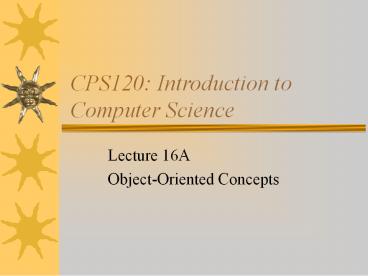CPS120: Introduction to Computer Science - PowerPoint PPT Presentation
1 / 17
Title:
CPS120: Introduction to Computer Science
Description:
CPS120: Introduction to Computer Science Lecture 16A Object-Oriented Concepts – PowerPoint PPT presentation
Number of Views:103
Avg rating:3.0/5.0
Title: CPS120: Introduction to Computer Science
1
CPS120 Introduction to Computer Science
- Lecture 16A
- Object-Oriented Concepts
2
The Procedural Paradigm
- The functions and algorithms are the focus, with
data viewed as something for the functions to
manipulate
3
Object-Oriented Paradigm
- Data should be placed inside the objects and that
these objects should communicate with each other
in the form of messages
4
OOP
- Object-oriented programming (OOP) is the process
of developing programs using the object-oriented
paradigm
5
Classes
- The definition of an object is know as a class
- It is similar to using basic data structures in
C - When you declare an object, you are said to have
instantiated it (given it instances) - Objects are members of a class
- Paul Millis, George Bush and George Washington
being members of the human being class - The design of a class is as important as its
implementation
6
Including Classes in C
- For classes, the include directive uses
different punctuation for header (.h) files - Quotation marks are used when the header file is
a source file in the same location as the program
source code - Angle brackets are used when the header file is
one of the compiler's pre-compiled library
functions
7
Using Header Files for Classes
- Header files normally contain declarations of
variables, functions and classes, but not
implementations of the functions and classes
8
Designing a Class
- Think in an object-oriented way
- E.g. an answering machine encapsulates the
functions of an answering machine with the data
(messages). - The buttons are the equivalent of sending
messages to the machine
9
Defining a Class
- Functions and variables that are prototyped and
declared in a class definition are called members
10
Public vs Private
- Private cannot be accessed outside the object
- Public Can have access to all the variables and
functions
11
Constructors
- Allow all data encapsulated within an object to
be initialized to preset values so that errors
can be avoided
12
Member Functions
- Provide a way for a programmer to pass data to
and get data from an object - Implemented like a normal C function
- Except -- The class name and the scope-resolution
operator ( ) precede the function name - circle circle() // default constructor
13
OOP Advantages Reusability
- Reusability is a major benefit of object-oriented
programming
14
OOP Advantages Containment
- Containment is a term used to describe an object
that contains one or more objects as members - (Passes the 'has-a' rule)
15
OOP Advantages Inheritance
- Inheritance is the term used to describe an
object that inherits properties from another
object - (Passes the 'is-a' rule)
- The class from which an object inherits
properties is called a parent class or base class - The class that inherits the properties is called
a child class or derived class
16
Multi-level Inheritance
- Inheritance can be multi-level (i.e. from
grandparents)
17
Multiple Inheritance
- Objects can inherit properties form multiple
objects - Multiple inheritance should be used sparingly






























